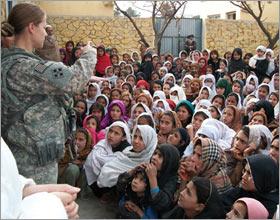Getting to Know You
The U.S. military maps the human terrain of Afghanistan.
BY Claudia Anderson
In early 2003, a single American diplomat and more than 5,000 American troops were stationed in Kandahar, the second city of Afghanistan and the heart of former Taliban country. The troops mostly stayed on their base, penned off near the airport, isolated from the people of the city. One of the few American civilians then living in Kandahar, the former NPR reporter Sarah Chayes, would describe the tedious hours-long delays and “bewildering lack of system” that governed access to the base. Isolation reinforced ignorance, and under the Americans’ noses, the provincial governor, a former warlord named Gul Agha Shirzai, exploited his position to snag most U.S. contracts for his Barakzai tribe and to cover his private militia—issued American camouflage uniforms—with impunity for misdeeds from drug smuggling to stealing.
As a result, wrote Chayes in her 2006 book The Punishment of Virtue: Inside Afghanistan after the Taliban, “much of the [U.S.] expenditure in effort and treasure that was aimed at building bridges and gaining friends in Kandahar did the reverse. It built a growing feeling of resentment against the U.S. troops.”
In those early days, the U.S. military in Afghanistan, for all its famous night-vision goggles, was blind to what has become known as the “human terrain”—the people it had come to liberate. No one has to explain to any soldier the tactical significance of a hill or a river or an airfield; whereas few soldiers on the Kandahar base had ever heard of Barakzais, much less the Popalzais and Alokozais and Ghiljais who had been left out in the cold. Their commanders similarly failed to recognize the mischief flowing every day from the fact that the interpreters on whom the Americans were wholly dependent—supplied by the governor’s helpful brother—were working for him.
Today efforts are being made to change that, as the military draws on a culture of “lessons learned”—the systematic practice of looking back at mistakes to see what can be done better. The generals in charge of the counterinsurgency strategy being implemented in Afghanistan are graduates of the hard school of Iraq, where the United States also paid the price of ignorance. Now, the generals—notably U.S. Central Command (CENTCOM) chief David Petraeus and the commander of coalition forces in Afghanistan, Stanley McChrystal—are working through multiple channels to build their forces’ ability to relate to the Afghan population.
The whole thrust of counterinsurgency doctrine is summed up in the subhead to the “Guidance” McChrystal issued to the troops in August: “Protecting the people is the mission.” There is abundant evidence that commanders are reorienting the coalition effort to this end.
Click here to read the rest of this great article

